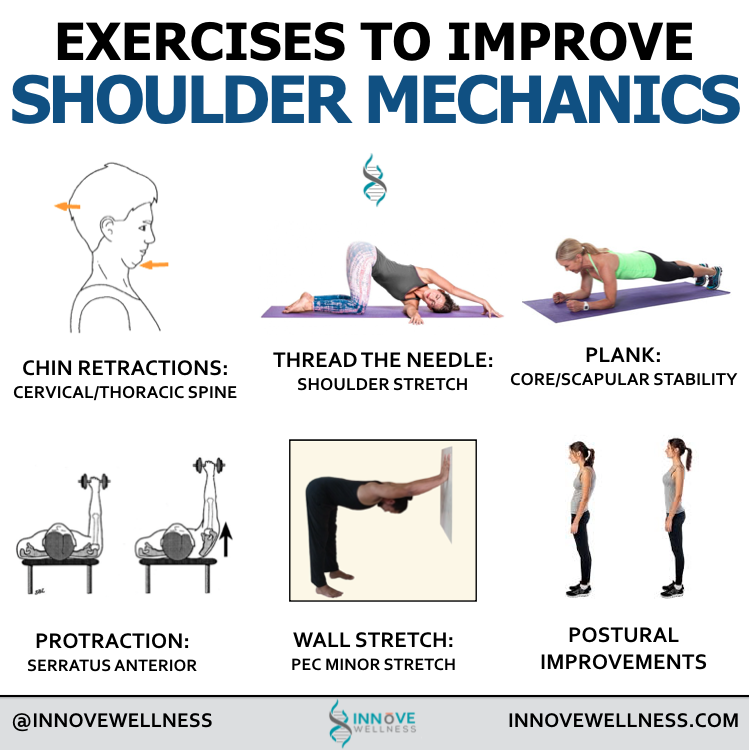Shoulder Impingement: Causes, Symptoms, Treatments
Shoulder pain is one of the most common musculoskeletal complaints. There may be many causes of shoulder pain, but the most common cause stems from entrapment of soft tissues in a group of muscles called the rotator cuff due to shoulder impingement.
The rotator cuff is a group of four muscles that help to move and stabilize the shoulder. They wrap around the shoulder to cover the joint and attach the shoulder blade to your upper arm.
Sources of pain stemming from shoulder pain and the rotator cuff may come from several structures including the tendons (tendinitis), bursa (bursitis), and joint (impingement).
Shoulder Impingement:
Shoulder impingement is the painful entrapment of soft tissues in the area of the shoulder joint. Over time this entrapment can increasingly cause irritation to the soft tissue, leading to tendinitis, bursitis, and other painful conditions.
Shoulder impingement is the third most common musculoskeletal complaint and one of the most common underlying problems with shoulder pain.
Causes:
Shoulder impingement can have many causes which may be structural or functional in nature.
Structural Impingement:
Structural shoulder impingement is caused by narrowing or abnormal position of the shoulder joint, thickening of the soft tissue (bursitis, tendinitis).
Functional Impingement:
Functional shoulder impingement is caused by abnormal function and movement of the shoulder leading to soft tissue entrapment. The main cause of functional impingement is muscular imbalances which cause abnormal displacement of the joint and altered movement patterns of the shoulder/shoulder blade.
The Scapula:
The scapula, also known as the shoulder blade, plays and important role in shoulder impingement and shoulder function. 19 muscles, including the muscles of the rotator cuff attach to the scapula and any imbalances in these muscles can throw off the normal function and rhythm of the scapula and upper arm; leading to impingement.
With normal shoulder function, the scapula provides a stable base for shoulder mobility. When the scapula is not functioning properly due to muscle imbalances, shoulder injury is a likely result.
Symptoms:
Symptoms of shoulder impingement are commonly due to the irritation of the shoulder, leading to swelling and tenderness in the front of the shoulder. Tenderness and pain often occurs when lifting the arm or lowering it from an elevated position.
When shoulder impingement occurs, the pain may be mild at the beginning. This pain may be present with activity and rest, with increased pain with lifting or reaching movements.
If this early stage of impingement is not treated, more irritation can occur and symptoms may progress. This progression may lead to more frequent and severe pain including pain at night and difficulty doing normal daily activities that involve lifting the arm. A loss of strength and motion may also be seen with progression of shoulder impingement.
Treatments:
In the absence of major structural damage, conservative treatment for 3-6 months is the recommended therapy for shoulder impingement (1).
The goal of treatments for shoulder impingement are to reduce inflammation and restore normal biomechanics in the shoulder, scapula, and core. There are three phases of rehabilitation for shoulder impingement.
Phase One: Pain Relief
This phase focuses on removing inflammation and reducing pain in the shoulder. Many of these therapies are passive and do not include exercises. During this phase, movements that cause pain should be avoided.
Therapies include some that can be performed at home, and others that require the use of a skilled healthcare provider. These therapies include:
Dry Needling/Acupuncture
Cryotherapy (Ice)
Laser therapy
Natural Anti-inflammatories (CBD, curcumin, etc.)
Taping
Phase Two: Increase Mobility
Mobility
Phase II: Mobilization
During phase II of treatment for shoulder impingement the main goal is to mobilize the joint, restore range of motion, and begin to improve biomechanics of the shoulder joint.
This phase includes many therapies which are performed by a skilled healthcare provider to help stretch the muscles and increase function of the joint. Some excellent therapies during this phase include the following:
Stretching
Pin & Stretch
Myofascial Release Techniques (manual & instrument-assisted)
Joint Mobilization
Joint Manipulation
Electric Muscle Stimulation
Phase Three: Increase Strength & Correct Imbalances
The final phase of treatment for shoulder imbalances is the most active portion and arguably the most important. This phase works to improve function of the joint to prevent further injury or recurrence.
Because weakness, tightness, and muscle imbalances are commonly the cause of functional shoulder impingement, it is essential to correct them. Here are some examples of phase three exercises.
Serratus Anterior strengthening
Upper Trapezius stretching
Posterior shoulder stretching
Pectoralis minor stretching
Thoracic spine extension exercises
Postural Improvements
Core Strengthening Exercises
The Bottom Line:
Shoulder impingement can be a bothersome and difficult to treat condition but with proper rehabilitation it can be fixed. It is important to have a sound rehab protocol and the help of a healthcare provider.

